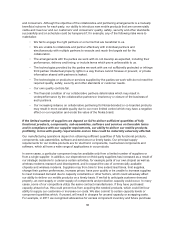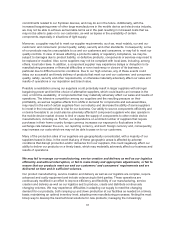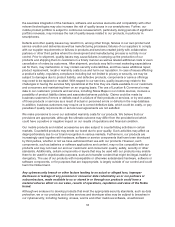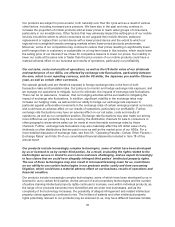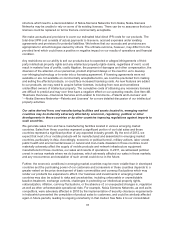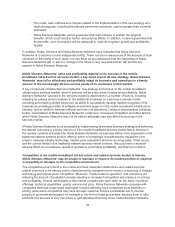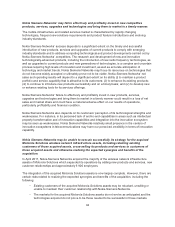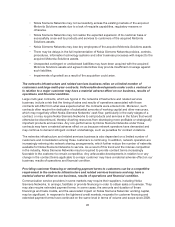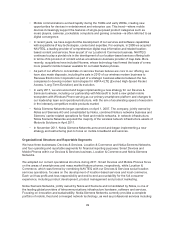Nokia 2011 Annual Report Download - page 41
Download and view the complete annual report
Please find page 41 of the 2011 Nokia annual report below. You can navigate through the pages in the report by either clicking on the pages listed below, or by using the keyword search tool below to find specific information within the annual report.including the need to engage external advisors, and consume significant time, attention and resources
of our management. As a global company, we are subject to various legislative frameworks and
jurisdictions that regulate fraud committed in the course of business operations and as such the extent
and outcome of any proceedings is difficult to estimate. Further, our business and results of operations
may be adversely affected by regulation and trade policies favoring the local industry participants as
well as other measures with potentially protectionist objectives which host governments in different
countries may take, particularly in response to difficult global economic conditions.
We have operations in a number of countries and, as a result, face complex tax issues and
could be obligated to pay additional taxes in various jurisdictions.
We operate our business in a number of countries which involve different tax regimes and the
application of rules related to taxation. Applicable taxes, VAT and social taxes for which we make
provisions could increase significantly as a result of changes in applicable tax laws in the countries
where we operate, the interpretation of those laws by local tax authorities or tax audits performed by
local tax authorities. The impact of these factors is dependent on the types of revenue and mix of profit
we generate in various countries; for instance, profits from sales of devices or services may have a
different tax treatment. Tax losses recognized in deferred taxes are dependent on our ability to offset
such tax losses against either other taxable income or future taxable income within the relevant tax
jurisdiction. Tax losses recognized within deferred taxes are based on our assumptions for future
taxable earnings and these may not occur as planned, which may cause the deferred tax asset to be
reduced. There can be no assurances that an unexpected reduction in deferred tax assets will not
occur. Any such reduction could have an adverse effect on us. Additionally, our earnings have been
and may continue to be in the future unfavorably impacted by Nokia Siemens Networks taxes as no tax
benefits are recognized for certain Nokia Siemens Networks deferred tax items. There may also be
unforeseen tax expenses which may have an unfavorable impact on us. As a result and given the
inherent unpredictable nature of taxation, there can be no assurance that the estimated long-term tax
rate of Nokia will remain at current levels or that cash flows regarding taxes will be stable.
Our operations rely on the efficient and uninterrupted operation of complex and centralized
information technology systems and networks. If a system or network inefficiency, malfunction
or disruption occurs, this could have a material adverse effect on our business and results of
operations.
Our operations rely on the efficient and uninterrupted operation of complex and centralized information
technology systems and networks, which are integrated with those of third parties. All information
technology systems are potentially vulnerable to damage, malfunction or interruption from a variety of
sources. We pursue various measures in order to manage our risks related to system and network
malfunction and disruptions, including the use of multiple suppliers and available information
technology security. However, despite precautions taken by us, any malfunction or disruption of our
current or future systems or networks such as an outage in a telecommunications network used by any
of our information technology systems, or a breach of our cybersecurity, such as an attack by a virus or
other event that leads to an unanticipated interruption or malfunction of our information technology
systems or networks or data leakages, could have a material adverse effect on our brand image,
business and results of operations. In addition, if we fail to successfully use our information technology
systems and networks, our operational efficiency or competitiveness could be impaired which could
have a material adverse effect on our business and results of operations. A disruption, for instance, in
our mail, music and maps services, could cause significant discontent among users of our products
resulting in claims or deterioration of our brand image.
39



